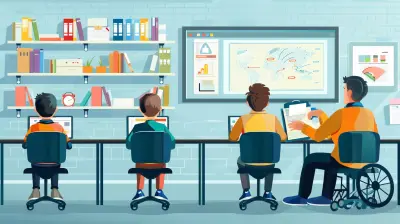The Art of Differentiated Instruction: Meeting the Needs of All Learners
4 June 2025
Education isn't one-size-fits-all. Walk into any classroom, and you'll see a mix of abilities, learning styles, and interests. Some students grasp concepts quickly, while others need more time. Some thrive on group discussions, while others prefer individual work. So, how do teachers ensure every student gets what they need?
Enter differentiated instruction—the teaching approach that tailors learning experiences to meet students where they are. This method is a game-changer in modern education, ensuring that no child is left behind and every learner has the opportunity to succeed.

What Is Differentiated Instruction?
Differentiated instruction (DI) isn't about creating 30 different lesson plans for 30 students. Instead, it's about adapting instruction based on students' needs, learning preferences, and readiness levels. It's a flexible approach that recognizes that students vary in their strengths and challenges.At its core, DI is about fairness, not sameness. Think of it like a buffet instead of a pre-set meal—students can take what they need in the way that works best for them.

The Four Key Elements of Differentiated Instruction
Carol Ann Tomlinson, a pioneer in differentiated instruction, outlined four key areas where teachers can differentiate:1. Content – What Students Learn
Not all students need the same level of challenge. Some may require more foundational support, while others crave enrichment. Differentiating content means adjusting how complex the material is or allowing students to choose from various resources.Example: In a history lesson, one group might read a basic summary of the Civil War, while another dives into primary source documents.
2. Process – How Students Learn
Students process information differently. Some need visuals, others benefit from hands-on activities, and some prefer listening. Teachers can vary how students engage with the content.Example: In a math class, one student might use manipulatives to solve equations, another watches a video tutorial, and another works through textbook problems.
3. Product – How Students Show Their Learning
A traditional test isn’t the only way to measure understanding. Differentiating the product allows students to demonstrate learning in ways that suit their strengths.Example: Instead of a written report on the solar system, students could choose to create a model, record a podcast, or design a slideshow.
4. Learning Environment – Where and With Whom Students Learn
The classroom environment plays a crucial role in learning. Some students thrive in quiet areas, while others learn best in collaborative settings. Offering different workspaces and group dynamics enhances learning.Example: A reading corner for independent work, small-group tables for collaboration, and a teacher-led station for direct instruction.

Why Differentiated Instruction Matters
Differentiated instruction isn't just a trendy educational buzzword—it has real benefits.✅ Increases Student Engagement – When students learn in ways that make sense to them, they’re more likely to stay interested and involved.
✅ Boosts Confidence & Motivation – Struggling students get the support they need, and advanced learners stay challenged—everyone wins.
✅ Promotes Equity in Education – Every student, regardless of ability level, gets a fair chance to succeed.
✅ Encourages Independence – Students take ownership of their learning, choosing methods that work best for them.

Practical Strategies for Implementing Differentiated Instruction
So, how can teachers bring differentiated instruction into their classrooms without feeling overwhelmed? Here are some practical strategies that work.1. Use Flexible Grouping
Instead of sticking with fixed ability groups, mix students up based on skills, interests, or learning preferences. Some groups might focus on peer tutoring, while others work on independent projects.2. Provide Choice Boards
Give students options for how they complete an assignment. A choice board might include writing an essay, creating a video, drawing a comic strip, or building a model.3. Incorporate Tiered Assignments
Offer different levels of assignments based on students’ readiness. For example, all students could work on the same concept, but some may tackle more complex problems, while others focus on foundational skills.4. Utilize Technology
Tech tools like interactive apps, educational videos, and online quizzes allow students to work at their own pace, reinforcing concepts in personalized ways.5. Assess in Different Ways
Not every student needs to take a traditional test. Offer a mix of assessments—oral presentations, projects, portfolios, or peer evaluations—to gauge understanding.6. Encourage Student Choice
Giving students some control over their learning boosts engagement. Let them choose topics for a research project or select books based on their interests.7. Use Ongoing Assessment & Feedback
Frequent check-ins help teachers understand how students are progressing. Quick quizzes, one-on-one conferences, and observation provide insight into who needs more support or challenge.Addressing Common Challenges in Differentiated Instruction
Is DI easy? Definitely not. But is it worth it? Absolutely. Let’s tackle some common concerns."I Don’t Have Enough Time!"
Time is a teacher's biggest challenge. The good news? Differentiation doesn’t require completely different lessons—just small tweaks. Even simple choices, like offering students two assignment options, can make a difference."Won’t This Increase My Workload?"
At first, it might feel overwhelming, but once systems are in place, differentiation actually reduces workload. Students become more independent, and teachers spend less time reteaching material."How Do I Make Sure It’s Fair?"
Fair doesn’t mean identical. Giving each student what they need is the ultimate fairness. Think of it like giving glasses to those who need them—everyone sees the board clearly.
The Future of Differentiated Instruction
With advancements in technology and research-backed teaching strategies, differentiated instruction will only continue to grow. AI-powered learning platforms, adaptive assessments, and personalized learning plans are making it easier for teachers to cater to individual student needs.But at its heart, differentiation isn't about fancy tools—it’s about teachers knowing their students, understanding their needs, and designing lessons that set them up for success.
Final Thoughts
Differentiated instruction isn’t an extra task—it’s a mindset shift. It’s about recognizing that every student is unique and deserves a chance to thrive in a way that works for them.So, whether you’re a seasoned educator or just starting, remember this: the best classrooms aren’t the ones where everyone learns the same way. They’re the ones where every student feels seen, supported, and challenged.
all images in this post were generated using AI tools
Category:
Teacher TrainingAuthor:

Anita Harmon
Discussion
rate this article
3 comments
Brittany Carrillo
Empowering every learner—brilliant insights here!
June 17, 2025 at 2:53 AM

Anita Harmon
Thank you! I'm glad you found the insights helpful!
Eliana Thompson
Thank you for this insightful article! It highlights the importance of differentiated instruction in fostering an inclusive classroom. I'm inspired to implement these strategies to better support all my students' unique learning needs.
June 9, 2025 at 7:52 PM

Anita Harmon
Thank you for your kind words! I'm glad you found the article inspiring and helpful for your teaching. Best of luck with your implementation of differentiated instruction!
Mandy O'Brien
Essential strategies for inclusive learning success.
June 4, 2025 at 5:01 AM

Anita Harmon
Thank you! Inclusive learning success relies on understanding individual needs, fostering a supportive environment, and employing diverse teaching strategies to engage every learner effectively.



